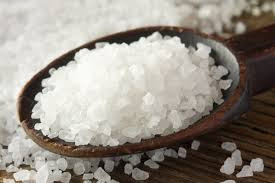Amazing salt for skin
Salt can be used to reduce facial oiliness. For this purpose, fill a small spray bottle with tepid water mixed with 1 teaspoon salt and mist on your face. Be careful to avoid your eyes. This acts as a skin toner.
Salt Scrub
Salt scrub can be used for scrubbing your arms and legs to exfoliate dead cells and improve circulation. After taking a shower or bath when your skin is still wet, sprinkle some salt on your hands and rub it gently on arms and legs.
. Salt As Facial Steamer
Steaming your skin with salt water before exfoliating it opens up your pores. Boil 1/3 cup of sea salt in a small pan of water and pour the solution in a bowl. Now cover your face with a towel, hold it over the steam for about 10 minutes.
can Make You Look Younger
If I am not wrong, this should be your favorite reason to take salt water baths! Who doesn’t want to look and feel younger! Regular use of bath salts decreases the appearance of wrinkles and fine lines. They leave the skin soft and supple. Bath salts achieve this by plumping the skin and balancing the skin moisture
Tips On Usage
1. Making Dead Sea Salt At Home
Dead Sea salt boasts of many skin benefits that help replenish and rejuvenate your skin. It helps lock moisture in your skin, reduces wrinkles and kills acne-causing bacteria. Dead sea salt is used as an ingredient in many organically prepared face masks and facial creams.
Ingredients
45 gm or 1 lb glycerin bar
¼ cup sea salt
½ tsp common salt
3-4 drops lavender essential oil
½ tbsp beeswax
Measuring cup (microwave-safe)
Rubbing alcohol (small spray bottle)
Wood spoon
Rectangular, triangular or circular soap molds
Soap cutter
Colorant
Directions
Begin by cutting the glycerin bar into 1-inch squares. Cutting the glycerin up into pieces ensures that your glycerin melts evenly and does not dry out.
Once the glycerin melts, pour it out into a measuring cup and keep it aside. (You can use the double boil method to melt the glycerin, or you can simply microwave it).
Make sure that all the glycerin is melted, and no air bubbles show up on the glycerin’s surface. Spray some alcohol on the air bubbles so that they subside.
Take the glycerin and set it over a low flame.
Using a wooden spoon or a wooden stick, stir the glycerin.
Now add the sea salt, table salt, beeswax and the lavender essential oil in stages. Don’t add them all together, add them in stages, stirring them in continuously.
The colorant part comes now. If you want your soap to look pretty, add a few colorant drops here.
Once you have done so, pour the mixtures into the soap mold and set aside for it to harden.
If the soap forms any air bubbles, spray some alcohol on it again.
Usually, the soap will take at least 24 hours to harden.
Once the soap hardens, use a soap cutter or a long knife to cut the soap into pieces.
Wrap the soap up in a plastic cling film to keep the glycerin from drying out.
Your soap is ready!
Once you have used these containers to make the soap, don’t store food or water in them; use them only for making soap, or get rid of them.



Comments
Post a Comment